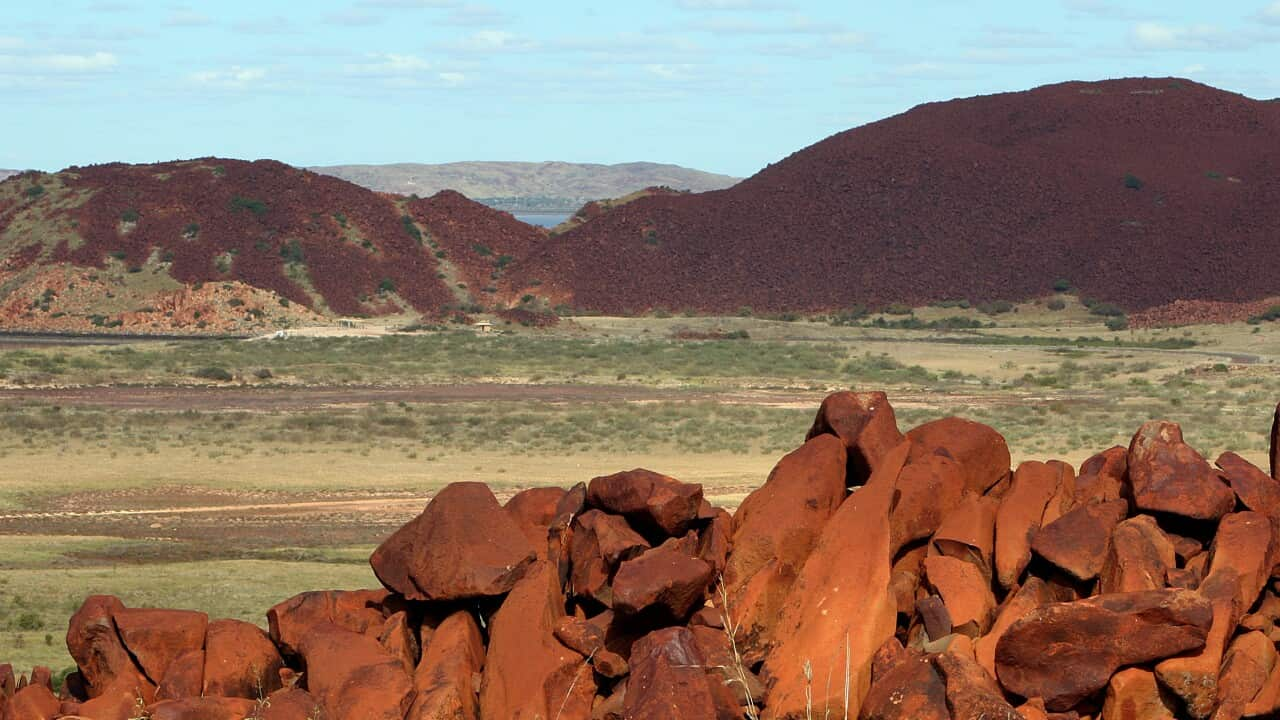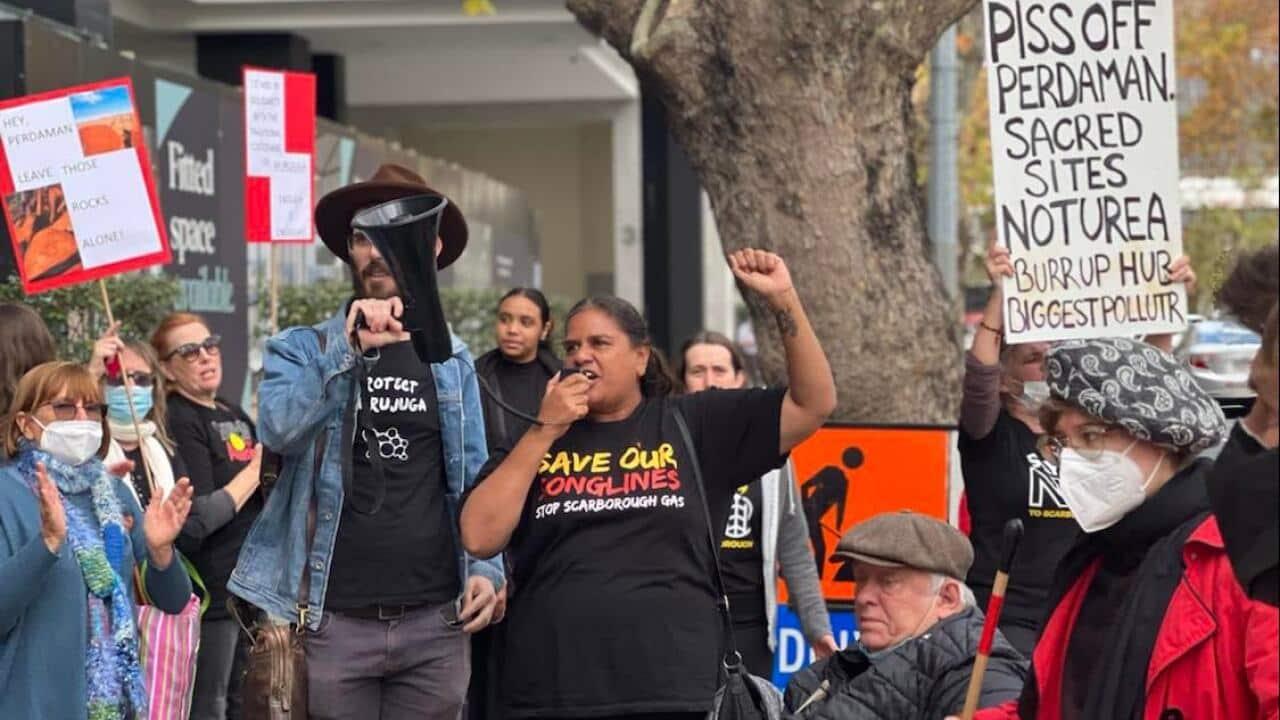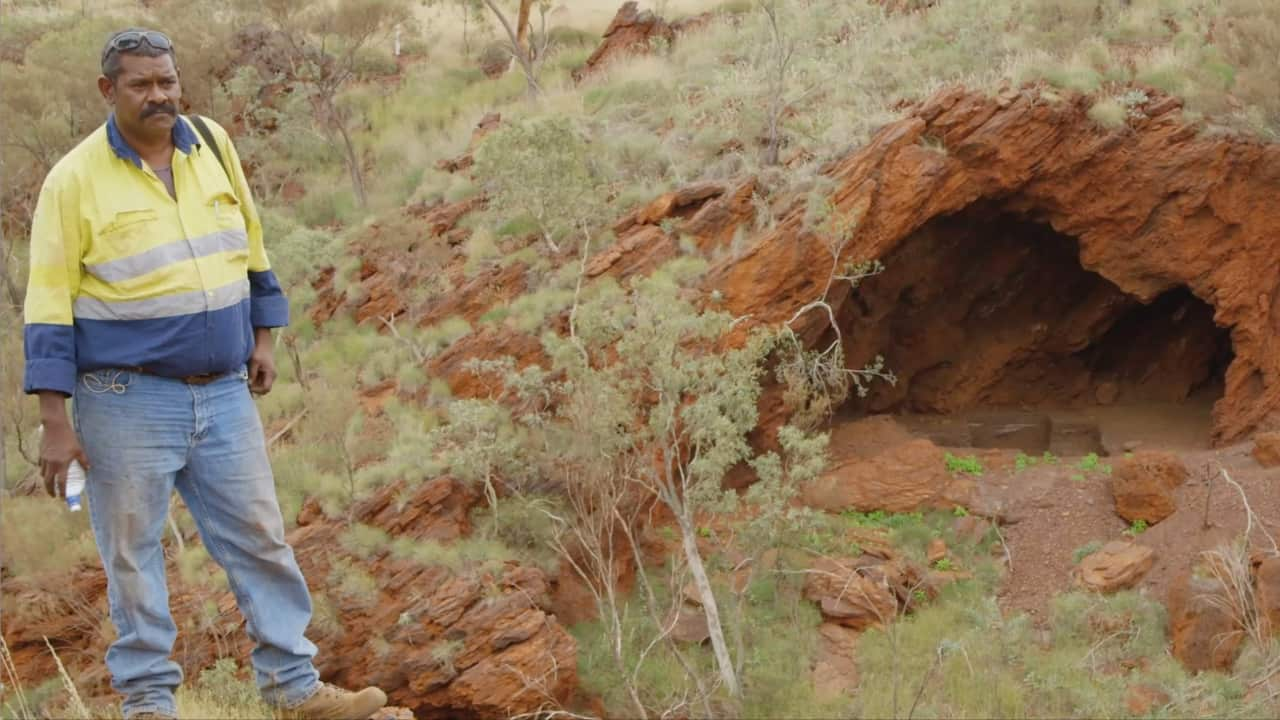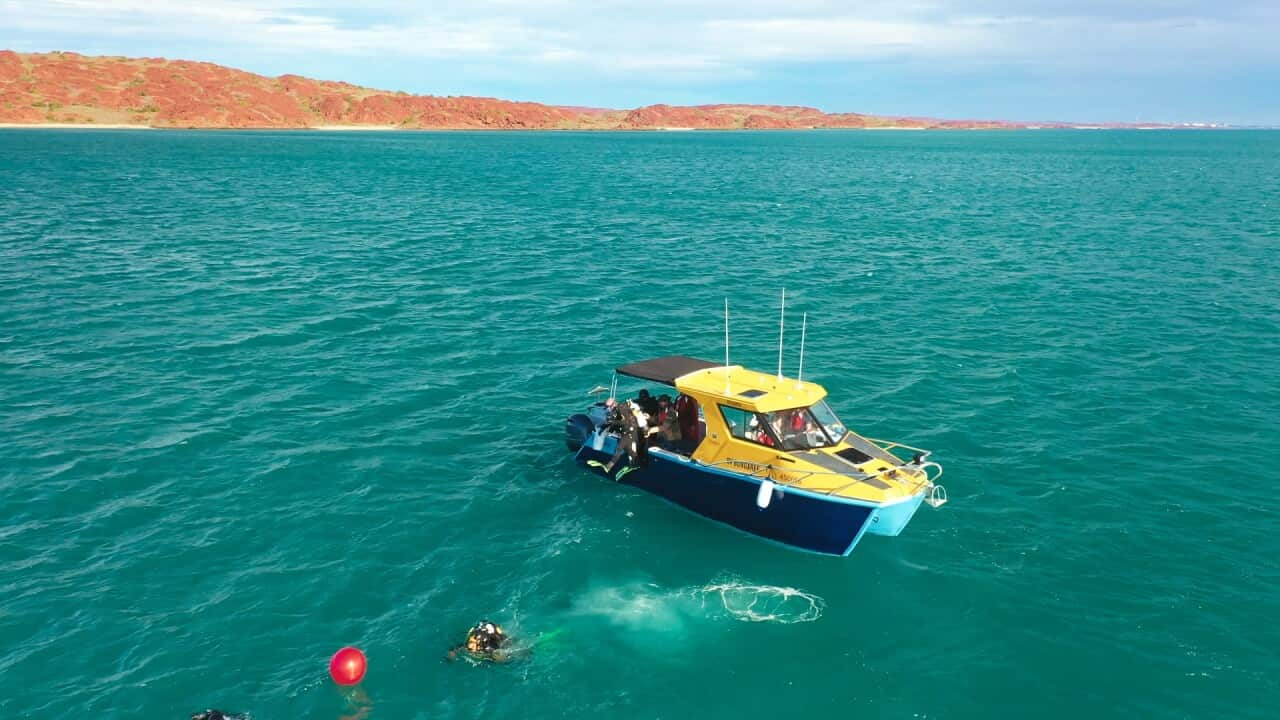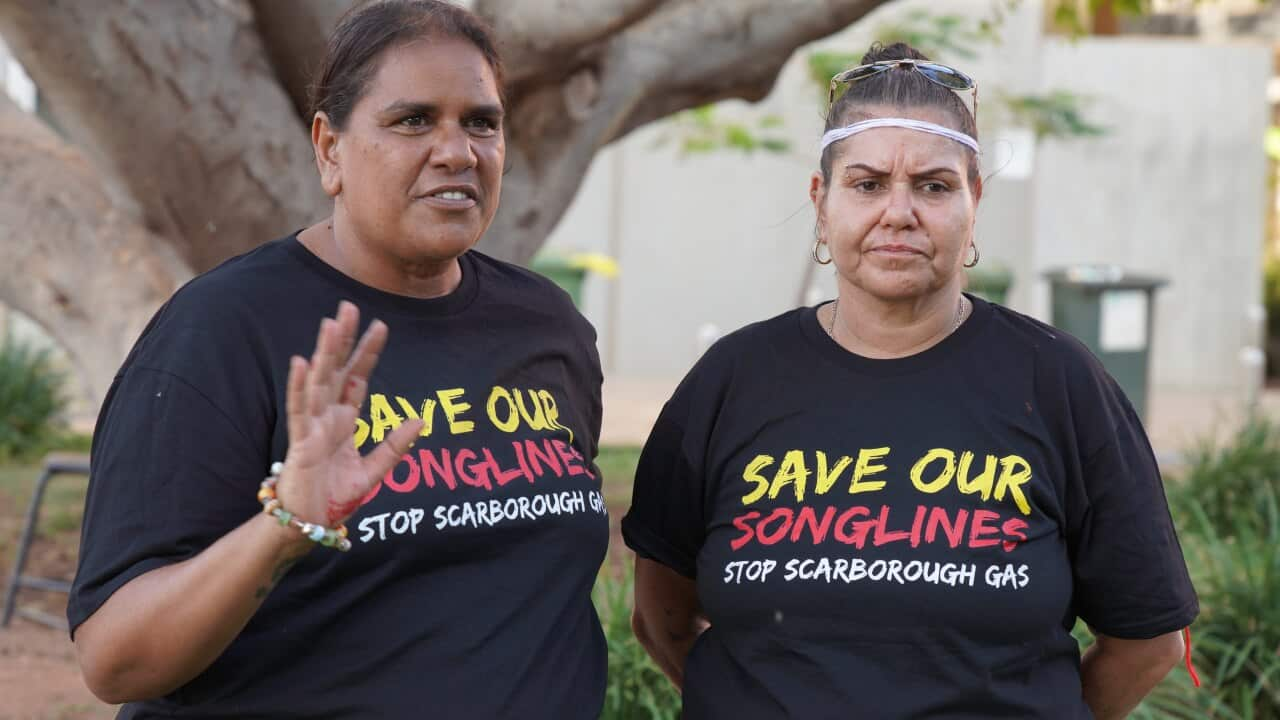

7 min read
Feature
Oldest art gallery in the world at risk as Traditional Owners are being gagged from objecting to development
Murujuga, in northern WA, is the only place on Earth where the story of the people and their changing environment has been continuously recorded through art for more than 50,000 years.
Published 30 August 2024 1:13pm
By Rudi Maxwell
Source: NITV
Image: Josie Alec and Raelene Cooper are fighting to protect Murujuga, a unique collection of petroglyphs on the Burrup peninsula. (Supplied)
Traditional custodians are being gagged from objecting to developments on the Burrup peninsula, according to evidence tendered in a Senate inquiry on Monday.
The oldest art gallery in the world, Murujuga, sits on the Burrup peninsula in northern Western Australia.
Adjacent to this extraordinary collection of an estimated one to two million petroglyphs – rock art created by engraving the surface – is a huge industrial centre, with Australia’s second largest bulk export port, LNG processing plants and an ammonium nitrate production facility.
And while Traditional Owners, scientists and environmental advocates have been warning of the risks industry poses to Murujuga for decades, government and industry have consistently asserted there are none.
On Monday Mardudhunera woman Raelene Cooper, Kuruma Mardudhunera woman Josie Alec and the CEO of the Murujuga Aboriginal Corporation (MAC) Kim Wood gave evidence at a public hearing for the Senate Environment and Communications Legislation Committee inquiry into the Protecting the Spirit of Sea Country Bill, proposed by Greens Senator Dorinda Cox.
Protected under Parliamentary privilege, Mr Wood said that, despite extensive opposition to some developments from its board and members, MAC doesn’t have the ability to say no.
“The no objection clause, which, frankly, we and I'm sure everybody else in Murujuga Country finds offensive, doesn't allow us to object,” he said, adding that MAC is not a decision-making body, but provides cultural and heritage advice to industry and government.
“No one is happy with what is happening on the Burrup, but we have limited ability to stop it.
“Anything we see happening on Murujuga is wrong, but we understand that industry will continue and we can’t stop that.”
Earlier in the hearing Senator Cox read onto the record the no-objections clause contained in the Burrup and Maitland Industrial Estates Agreement (BMIEA), signed by representatives of the Ngarluma-Yindjibarndi, Wong-Goo-Tt-Oo, and Yaburara Mardudhunera peoples in 2003.
Traditional Owners received land entitlements and financial benefits as compensation for surrendering their native title rights and interests and discontinuing their native title determination applications in the Federal Court over the land and waters of the Burrup.
MAC is the approved body corporate for the BMIEA and oversees the implementation and contractual obligations of the agreement.
A clause in the BMIEA says Traditional Owners of the Burrup will not lodge or cause to be lodged any objection to development proposals intended to occur on land within the industrial estate.
Ms Cooper, a former chair of MAC who resigned in part because of the restrictions in the no-objections clause, has been fighting to protect Murujuga and is a spokesperson for Save our Songlines.
In early 2022, Ms Cooper applied to protect Murujuga from further industrial expansion under Section 10 of the Aboriginal and Torres Strait Islander Heritage Protection Act.
She is still waiting for a decision. In the meantime, the Australian and WA governments have approved more developments, including the Perdaman Urea Project, which will convert gas from Woodside's Scarborough Gas Project into an estimated 2.3 million tonnes of urea per year.
Urea, which is manufactured synthetically by reacting natural gas, atmospheric nitrogen and water together at high temperatures and pressure to produce ammonia and carbon dioxide, is a widely used form of fertiliser.
Yara also has a fertiliser plant on the Burrup, manufacturing ammonia, another nitrogen compound.
Last year Ms Cooper won a legal bid against energy giant Woodside, stopping the company from conducting seismic blasting offshore from Murujuga as part of its Scarborough Gas Project.
The Federal Court accepted that the National Offshore Petroleum Safety and Environmental Management Authority (NOPSEMA) made a legal error.
“Just weeks after my victory NOPSEMA waved through Woodside’s application anyway and they started blasting our sacred whale songlines,” Ms Cooper told the hearing on Monday.
“I am heartbroken, devastated and furious that our governments continue to allow Woodside, Perdaman and Yara to destroy our sacred rock art, our Songlines and our precious marine sanctuaries.
“There has never been genuine consultation under the principles of free, prior and informed consent.
“When concerns were raised about the rock art monitoring by a whistleblower, who used to run the program for MAC, he was ignored, suppressed and dismissed from his position and threatened with legal action.”

Construction of new industry on the Burrup is continuing, despite concerns from Traditional Owners.
The Senate Inquiry is due to hand down its report on September 30.
Mr Wood told the hearing that the Murujuga Rock Art Monitoring program was currently being peer-reviewed and would report its findings later in the year.
There have been several research projects regarding the effects of emissions, acid and industry on Murujuga going back twenty years.
A previous Senate inquiry in 2017 heard from Professor John Black, who has published extensively on Murujuga, that corrosive emissions from the nearby petrochemical and fertiliser factories would have damaging impacts on the art, which includes the world's oldest depiction of the human face.
"I honestly believe that the level of acidity that is now proposed and probably already occurring on Burrup Peninsula will destroy the rock art," Professor Black said in 2017.
In an interview in June Professor Black said that while industry claims it can exist sustainably with rock art, there’s a pretty big caveat.
“They can only live together if there is absolutely no pollution,” he said.
"There are horribly staggering things here," he said.
"When Yara set up their ammonium nitrite plant ... they didn't put in proper connections and had all sorts of leaks and they had waste products that they were put putting into ponds.
"Those ponds were so badly made that they leaked."
In 2022 Professor Black was invited by the WA Department of Water and Environmental Regulation to comment on a works approval for Yara to rehabilitate land.
"In 2021, there was heavy rainfall, and it washed a whole lot of sediment that was on the surface that Yara had put into King Bay and killed a whole lot of fish," he said, adding that the company had advised the department in 2017 and 2018 that they'd had problems with the effluent ponds leaking.
Kuruma Mardudhunera woman Josie Alec, First Nations lead for the Australian Conservation Foundation, explained to the Senate hearing on Monday that Traditional Owners have an obligation to protect Country and Songlines.
“It is our obligation, and it sits in our hearts, our minds, our souls, everything that we are, we have a footprint to the Country,” she said.
“When we're talking about star law, it's the laws that govern from the stars down to the Country, to create the ebb and flow of everything that is natural, on land and in the ocean.
“There is an alchemy that happens between salt water and fresh water when it comes in and out of river systems, a special alchemy that has been given to us in stories passed down.
“Those stories that are passed down come down through rock art.”
